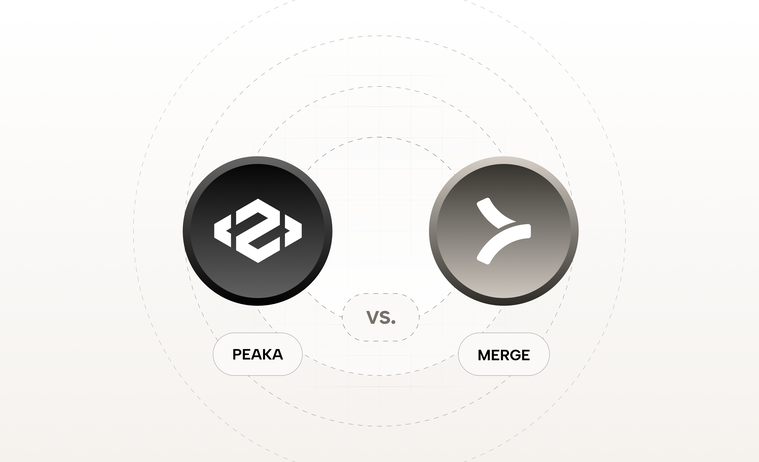Merge vs. Peaka: Which to Choose for In-Product Analytics?
If you’re building a SaaS platform that pulls in data from tools like Stripe, HubSpot, Zendesk, or QuickBooks, you’ve likely come across Merge and Embedded Peaka. Both promise faster integration with third-party APIs. But when your end goal is to go beyond syncing data to your backend and embed customer-facing analytics inside your product, there’s a big difference in what each platform delivers.
Here’s why Embedded Peaka is the better fit for product teams looking to ship dashboards, reporting, or AI-driven insights that users interact with inside the app.
1. You need an embedded data platform, not an API aggregator
Merge is excellent for connecting to APIs, especially if you’re dealing with HRIS, CRM, or accounting systems. But you are left to your own devices once that data reaches your backend, and you must develop an entire infrastructure to transform that data into the dashboards your customers desire.
Peaka collapses all of that into a single embeddable platform: Embedded Peaka. It not only pulls in data from scattered sources but also provides the UI components and white-labeling capability to make real-time in-product analytics possible.
| Feature | Embedded Peaka | Merge |
|---|---|---|
| Deployment Mode | ✅ Purpose-built for embedding | ❌ Backend APIs only |
| UI Components | ✅ Dialogs, query editor, autocomplete | ❌ None |
| Branding & Theming | ✅ Full white-labeling | ❌ None |
What this means for you
Merge is a good iPaaS solution, but if your goal is to facilitate customer-facing analytics, Embedded Peaka is the one to pick here.
2. Peaka supports live queries
Merge simplifies syncing data into your system. However, it still needs good ol’ ETL pipelines and data warehouses to serve the data. Building and maintaining such a stack can be rather costly, which SaaS companies can hardly afford.
Embedded Peaka removes that overhead. It allows live or cached queries without replication, giving you real-time insights from third-party data with no additional infrastructure investment.
| Feature | Embedded Peaka | Merge |
|---|---|---|
| Data Access Model | ✅ Live querying (no replication) | ❌ Requires syncing to DB |
| Query Engine | ✅ Built-in (Trino-based) | ❌ No SQL engine |
| Caching & Rate Limit Handling | ✅ Rate limit-aware caching built-in | ❌ No caching built-in |
What this means for you
For SaaS teams developing modern data products and AI tools, Peaka’s zero-ETL approach offers speed and agility that Merge simply doesn’t.
3. Peaka handles OAuth, governance, and multitenancy
Merge offers hosted OAuth flows, but leaves you to build tenant-level logic and access governance yourself. That means more code, more edge cases, and more delays.
Embedded Peaka takes a multi-tenant-first approach with:
-
Hosted or BYO OAuth with full tenant awareness
-
Project-, catalog-, and schema-level isolation
-
Role-, column-, and row-level permissions
-
Audit logs and data lineage tracking for compliance
| Feature | Embedded Peaka | Merge |
|---|---|---|
| OAuth | ✅ Hosted, tenant-aware | 🟡 Hosted flows only (non-customizable) |
| Multitenant Support | ✅ Native project/catalog isolation | ❌ To be built by the user |
| Connector Maintenance | ✅ Peaka-managed | 🟡 Backend APIs maintained by Merge |
What this means for you
In short: Merge connects. Peaka integrates, governs, queries, and displays, ensuring that product teams can focus on improving the embedded analytics experience they provide.
4. Peaka includes the frontend, so you don’t have to build it
Merge doesn’t provide frontend components. Want your users to explore their connected data? You’ll have to build an entire suit of components, including:
-
Query editors
-
Connector dialogs
-
Schema browsers
-
Visual theming
Embedded Peaka ships all of this, branded, styled, and ready to be embedded inside your platform.
What this means for you
Embedded Peaka gives you the tools you need to accelerate your road map, enabling you to make the most of your engineering resources.
Key takeaways
-
Merge.dev aggregates APIs, but it doesn’t provide a query engine, UI components, or multitenant governance for embedded analytics.
-
Embedded Peaka offers a full embedded data stack, including federated querying, smart caching, white-labeled UI, and OAuth handling.
-
Embedded Peaka eliminates the need for warehouses or ETL, allowing teams to query third-party data in real time, without syncing or replication.
-
Embedded Peaka reduces engineering overhead, enabling SaaS teams to ship in-product dashboards and analytics much faster than with Merge.
Final word: Embedded Peaka helps you build data products
Merge is a powerful backend integration tool. But for product managers, platform teams, and founders focused on delivering embedded data experiences to users, it’s only half the story.
Peaka gives you everything you need to integrate, govern, query, and visualize third-party data without standing up a warehouse or frontend framework.
Embedded Peaka = Merge + Trino + Looker + OAuth + Multi-tenant governance, all in one embeddable platform.
Explore Embedded Peaka or book a demo to see how Peaka replaces entire stacks of backend and frontend work.
Still comparing your options for embedded analytics?
We’ve broken down how Embedded Peaka compares to other platforms to help you make the most informed decision:




 Please
fill out this field
Please
fill out this field













